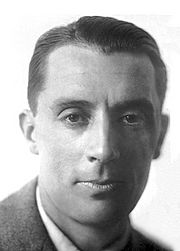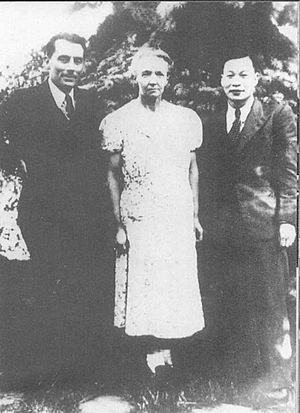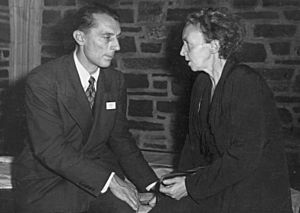Frédéric Joliot-Curie facts for kids
Quick facts for kids
Frédéric Joliot-Curie
|
|
|---|---|
 |
|
| Born |
Jean Frédéric Joliot
19 March 1900 Paris, France
|
| Died | 14 August 1958 (aged 58) Paris, France
|
| Nationality | France |
| Alma mater | University of Paris |
| Known for | Atomic nuclei |
| Spouse(s) | Irène Joliot-Curie |
| Children | Hélène Langevin-Joliot (b. 1927) Pierre Joliot (b. 1932) |
| Awards |
|
| Scientific career | |
| Fields | Physics, chemistry |
Jean Frédéric Joliot-Curie (born March 19, 1900, died August 14, 1958) was a famous French physicist. He was married to Irène Joliot-Curie. Together, they won the Nobel Prize in Chemistry in 1935. They earned this award for finding out how to make "artificial radioactivity". This means they could make stable elements become radioactive.
Contents
Discovering New Science
Early Life and Studies
Frédéric Joliot-Curie was born in Paris, France. He studied at a school called ESPCI Paris. In 1925, he started working as an assistant to Marie Curie. She was a very famous scientist at the Radium Institute.
Frédéric fell in love with Marie Curie's daughter, Irène Curie. They got married in 1926. After their marriage, they both decided to change their last names to Joliot-Curie. Marie Curie encouraged Frédéric to continue his studies. He earned more degrees, including a doctorate in science. His research focused on how radioactive elements behave in liquids.
Working Together
While teaching at the Paris Faculty of Science, Frédéric worked closely with his wife. They researched the structure of the atom. They studied how nuclei (the center of atoms) would recoil or bounce back when hit by other tiny particles. This work was very important. It helped other scientists, like Chadwick, discover the neutron in 1932. Neutrons are particles found in the nucleus of an atom.
In 1935, Frédéric and Irène won the Nobel Prize in Chemistry. They discovered "artificial radioactivity". This means they could create new, short-lived radioactive elements. They did this by hitting stable elements like boron, magnesium, and aluminum with alpha particles. This process changed the stable elements into radioactive ones.
New Roles and World War II
In 1937, Frédéric left the Radium Institute. He became a professor at the Collège de France. In 1939, he shared important news with a Soviet scientist. German physicists had found out that uranium could be split (called nuclear fission). This process released huge amounts of energy.
Frédéric then started working on nuclear chain reactions. He wanted to understand how to build a nuclear reactor. A reactor uses controlled nuclear fission to create energy. His work was so important that Albert Einstein mentioned him in a letter to President Roosevelt in 1939.
However, World War II slowed down Frédéric's research. He also had many duties after the war.
When the Nazis invaded France in 1940, Frédéric Joliot-Curie managed to send his important research papers and materials to England. He worked with other scientists to keep them safe. During the time France was occupied, he joined the French Resistance. This was a group that fought against the Nazi occupation.
During the Paris uprising in August 1944, Frédéric helped the Resistance. He made Molotov cocktails (simple firebombs) for them. These were used against German tanks. The police headquarters, where he was working, saw some of the toughest fighting during the uprising.
After the war, a team of Allied scientists found Frédéric Curie. He was sent to England for interviews. He shared important information about German scientists and their activities.
After the War
In 1944, French physicists working on the British nuclear weapons program returned to France. They told Frédéric Joliot-Curie about the progress of the American and British nuclear weapon programs. Frédéric shared this information with his Soviet friends.

Frédéric became the director of the French National Centre for Scientific Research. In 1945, Charles De Gaulle appointed him as France's first High Commissioner for Atomic Energy. In 1948, he oversaw the building of France's first atomic reactor.
Frédéric was a devoted communist. Because of his political views, he was removed from most of his duties in 1950. However, he kept his professorship at the Collège de France. In 1955, he was one of eleven scientists to sign the Russell–Einstein Manifesto. This was a statement calling for nuclear disarmament. After his wife died in 1956, he took over her position as a professor of Nuclear Physics at the Sorbonne.
Awards and Recognition
Frédéric Joliot-Curie was a member of the French Academy of Sciences and the Academy of Medicine. He was also named a Commander of the Legion of Honour. This is a very high award in France.
He received the first Stalin Peace Prize in 1951. This was for his work as president of the World Council of Peace.
A crater on the Moon is named Joliot after him. He also became a Foreign Member of the Royal Society in 1946.
Many places are named after Frédéric Joliot-Curie. These include a street in Sofia, Bulgaria, and the nearby Joliot-Curie Metro Station. Other streets with his name are in Montreal, Canada; Bucharest, Târgu-Mureș, and Cluj-Napoca, Romania; Warsaw and Wrocław, Poland; and Poprad, Slovakia.
Frédéric Joliot-Curie even appeared as himself in a 1948 film. It was called Kampen om tungtvannet (The Battle for Heavy Water). This film was about the sabotage of a heavy water plant during World War II. In the film, he is shown giving a lecture about nuclear fission and chain reactions.
Family Life
Frédéric and Irène added their last names together to become Joliot-Curie after they married on October 4, 1926. However, their daughter said that for scientific papers, they often signed as "Irène Curie and Frédéric Joliot."
Their daughter, Hélène Langevin-Joliot, was born in 1927. She became a nuclear physicist and a professor. Their son, Pierre Joliot, was born in 1932. He is a biochemist.
Frédéric Joliot-Curie spent his last years creating a center for nuclear physics in Orsay. His children later studied there.
- [[Category:Nobel Prize in {{{1}}} winners]] including the Nobel Lecture, December 12, 1935 Chemical Evidence of the Transmutation of Elements
Images for kids
See also
 In Spanish: Frédéric Joliot-Curie para niños
In Spanish: Frédéric Joliot-Curie para niños




